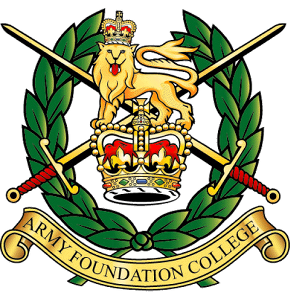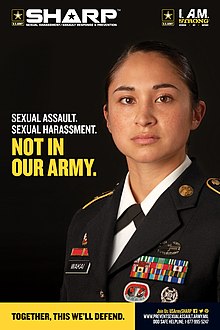
The Canadian Armed Forces are the unified military forces of Canada, including land, sea, and air commands referred to as the Canadian Army, Royal Canadian Navy, and the Royal Canadian Air Force. The CAF also operates several other commands, including the Canadian Forces Intelligence Command, the Canadian Joint Operations Command, and the Canadian Special Operations Forces Command.

Sexual harassment is a type of harassment involving the use of explicit or implicit sexual overtones, including the unwelcome and inappropriate promises of rewards in exchange for sexual favors. Sexual harassment can be physical and/or a demand or request for sexual favors, making sexually coloured remarks, showing pornography, and any other unwelcome physical, verbal, or non-verbal conduct of a sexual nature, verbal. Sexual harassment includes a range of actions from verbal transgressions to sexual abuse or assault. Harassment can occur in many different social settings such as the workplace, the home, school, or religious institutions. Harassers or victims can be of any gender.
Sexual misconduct is misconduct of a sexual nature which exists on a spectrum that may include a broad range of sexual behaviors considered unwelcome. This includes conduct considered inappropriate on an individual or societal basis of morality, sexual harassment and/or criminal sexual assault.

During the early stages of the Iraq War, members of the United States Army and the Central Intelligence Agency committed a series of human rights violations and war crimes against detainees in the Abu Ghraib prison in Iraq, including physical abuse, sexual humiliation, physical and psychological torture, and rape, as well the killing of Manadel al-Jamadi and the desecration of his body. The abuses came to public attention with the publication of photographs of the abuse by CBS News in April 2004. The incidents caused shock and outrage, receiving widespread condemnation within the United States and internationally.
The Air Force Academy sexual assault scandal in 2003 involved allegations of sexual assault at the United States Air Force Academy, as well as allegations that the alleged incidents had been ignored by the academy's leadership.

Sexual assault in the United States armed forces is an ongoing issue which has received extensive media coverage in the past. A 2012 Pentagon survey found that approximately 26,000 women and men were sexually assaulted that year; of those, only 3,374 cases were reported. In 2013, a new Pentagon report found that 5,061 troops reported cases of assault. Of the reported cases, only 484 cases went to trial; 376 resulted in convictions. Another investigation found that one in five women in the United States Air Force who were sexually assaulted by service members reported it, for one in 15 men.

Women have been serving in the military since the inception of organized warfare, in both combat and non-combat roles. Their inclusion in combat missions has increased in recent decades, often serving as pilots, mechanics, and infantry officers.
Counter-recruitment refers to activity opposing military recruitment, in some or all of its forms. Among the methods used are research, consciousness-raising, political advocacy and direct action. Most such activity is a response to recruitment by state armed forces, but may also target intelligence agencies, private military companies, and non-state armed groups.

Military recruitment refers to the activity of attracting people to, and selecting them for, military training and employment.

The Army Foundation College (AFC) in Harrogate, England, is the sole initial military training unit for British Army recruits who enlist aged between 16 and 17.5 years.
Sexual assault in the Canadian Armed Forces has been a pervasive issue affecting women, youth, and men in the Canadian Forces and Canadian Cadet Organizations. Canadian Forces sexual assault cases have been extensively reported in national Canadian news media. The scope and depth of the sexual assault problem first came to light in 1998, when Maclean's magazine broke the story. Individual cases continued to be reported. The issue became a national focus again when MacLean's magazine published another exposé exploring the extent of rape culture in Canada's military.
After a sexual assault or rape, victims are often subjected to scrutiny and, in some cases, mistreatment. Victims undergo medical examinations and are interviewed by police. If there is a criminal trial, victims suffer a loss of privacy, and their credibility may be challenged. Victims may also become the target of slut-shaming, abuse, social stigmatization, sexual slurs and cyberbullying. These factors, contributing to a rape culture, are among some of the reasons that may contribute up to 80% of all rapes going unreported in the U.S, according to a 2016 study done by the U.S. Department of Justice.

#MeToo is a social movement and awareness campaign against sexual abuse, sexual harassment, and rape culture, in which people publicize their experiences of sexual abuse or sexual harassment. The phrase "Me Too" was initially used in this context on social media in 2006, on Myspace, by sexual assault survivor and activist Tarana Burke. The hashtag #MeToo was used starting in 2017 as a way to draw attention to the magnitude of the problem.
The Weinstein effect is a global trend in which allegations of sexual misconduct by famous or powerful figures are disclosed. The first of a worldwide wave of allegations were made in the United States in October 2017, when media outlets reported on the allegations made against film producer Harvey Weinstein. They were described as a "tipping point" or "watershed moment" and precipitated an "international reckoning" against sexual harassment.

SHARP is a proactive U.S. Army program which aims to end sexual harassment and assault in the service. Sexual harassment is a crime in the armed forces, under the UCMJ Article 134 by executive order on 26 January 2022. Those accused of a crime such as sexual harassment,or assault are subject to the UCMJ. Victims of such crimes are protected from disciplinary action, or prosecution by Army Directive as of 2022. A Special Trial Counsel, part of the Judge Advocate General's Corps has been established to combat harmful behaviors, in order to conduct independent prosecutions.
This overview shows the regulations regarding military service of non-heterosexuals around the world.
The #MeToo movementin Pakistan is modeled after the international #MeToo movement and began in late 2018 in Pakistani society. It has been used as a springboard to stimulate a more inclusive, organic movement, adapted to local settings, and has aimed to reach all sectors, including the lowest rungs of society.
Major Sandra Marie Perron is a former Canadian Army officer. She was the first female infantry officer in the Canadian Army. Perron served in the infantry from 1991 to 1996, completing two tours of duty in Yugoslavia. While in the Army she was subjected to sexual harassment and "excessively rough" training.
Trevor John Cadieu is a retired senior Canadian military officer. He reached the rank of lieutenant general and was slated to become army commander, but released from the military following allegations of sexual misconduct almost 30 years before, and after months of delay in court proceedings. Cadieu maintained the allegations were false but needed to be investigated thoroughly to expose the truth. In 2022, he travelled to Ukraine to join the fight against the 2022 Russian invasion of Ukraine. In October 2023, the charges were stayed by an Ontario judge, ruling that unreasonable delays by military police to disclose information to Cadieu and another accused party led to unreasonable delay in the trial, denying justice to the accused, the complainant, their families and the public as a whole.

Sexual misconduct in the British military is unwanted sexual behaviour occurring in military organisations of the United Kingdom, including verbal and physical harassment, assault, and rape.













